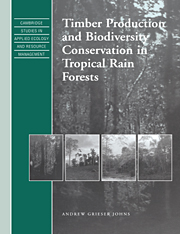Book contents
- Frontmatter
- Contents
- Foreword
- Preface
- Explanatory note
- 1 The issues
- 2 The history and development of tropical forestry
- 3 Changes in the physical environment
- 4 Forest regeneration and gap dynamics
- 5 Responses of individual animal species
- 6 Responses of species assemblages
- 7 Using ecological data in forest management planning
- 8 Intervention to maintain biodiversity
- 9 Field procedures
- 10 The future
- References
- Subject index
4 - Forest regeneration and gap dynamics
Published online by Cambridge University Press: 04 December 2009
- Frontmatter
- Contents
- Foreword
- Preface
- Explanatory note
- 1 The issues
- 2 The history and development of tropical forestry
- 3 Changes in the physical environment
- 4 Forest regeneration and gap dynamics
- 5 Responses of individual animal species
- 6 Responses of species assemblages
- 7 Using ecological data in forest management planning
- 8 Intervention to maintain biodiversity
- 9 Field procedures
- 10 The future
- References
- Subject index
Summary
Introduction
The impact of logging operations on tropical forest vegetation is reliant on two main factors, the number of trees removed and the care taken in doing so. The extent and type of any interventions applied subsequent to felling also affect the regenerative capability of the forest.
While tropical forests contain a very large number of tree species, relatively few are acceptable to the timber trade. Tropical forest timber logging is inevitable ‘selective’ to some degree. In peninsular Malaysia, for example, there are around 2500 tree species of which 700 reach a utilizable diameter. Of these 400 are considered to have commercial properties, but only about 30 are exported in significant quantities. The degree of selection is greater than this in many tropical countries. In parts of central Africa only a single species, Aucoumea klaineana, may be cut for commercial use.
However, felling timber trees is not the main cause of damage in tropical forestry operations. The majority of tree loss is caused by construction of access roads and particularly by the movement of hauling machinery between cut logs and loading points. This so-called ‘incidental damage’ inevitably greatly exceeds actual felling damage. Overall damage levels are much influenced by the extent to which hauling machine operators attempt to minimize damage during this stage of the logging operation (Crome et al. 1992). The degree of damage sustained during felling and log removal is critically important and determines the degree of change in forest structure and tree species composition, the size and frequency of gaps and the success of regeneration processes.
- Type
- Chapter
- Information
- Publisher: Cambridge University PressPrint publication year: 1997



